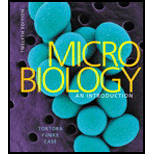
Concept explainers
Which of the following organisms are most closely related? Are any two the same species? On what did you base your answer?

To review:
Which of the given organisms are closely related. Any two of the following organisms are same species.
Introduction:
Bacterial species that show similar morphological and biochemical characteristics are generally grouped into a single genus. Characterization of organism using their genomic content denotes that the ratio of guanine and cytosine are similar in related species.
Explanation of Solution
The morphology, Gram reaction, GC percentage, glucose utilization, and presence or absence of cytochrome oxidase of four organisms are provided. The organism A (48-52%) and D (49-53%) possess almost similar amount of guanine and cytosine which is depicted in their GC percentage. However, cytochrome oxidase is present for aerobic respiration is present in organism A and it is absent in organism D. The morphology of both A and D organisms is rod-shaped and they both are gram-positive in nature. Both the organism undergoes fermentation process and utilize glucose. Thus, characteristics of organisms A and D organisms are much closely related compared to other organisms.
By comparing the characteristics of different organisms given, it is clear that organism A and D are most closely related compared to other organisms.
Want to see more full solutions like this?
Chapter 10 Solutions
Microbiology: An Introduction
Additional Science Textbook Solutions
Fundamentals of Anatomy & Physiology Plus Mastering A&P with eText - Access Card Package (10th Edition) (New A&P Titles by Ric Martini and Judi Nath)
Campbell Essential Biology with Physiology (5th Edition)
Microbiology: Principles and Explorations
Anatomy & Physiology
- Which organism are we most distantly related to and why do you think so?arrow_forwardBecause phrase names are generally more descriptive of organisms than binomials, do you think they should be revived?arrow_forwardCan you answer all the parts of this question about this picture A: This organism belongs to which class? B: What is the structure devoted by the green arrow?arrow_forward
- According to this chart, which organism is most closely related to humans, why do you think so?arrow_forwardExamine the following phylogenetic tree illustrated in Figure shown in the picture. In general, what does a phylogenetic tree illustrate? How do you compare the relationships of organisms BB, CC, and DD?arrow_forwardIn the following cladogram species A, B, C, and the root of the tree together represent what sort of group?arrow_forward
- What term is used to describe a single species exhibiting both celltypes shown below, and which types of organisms would most likelyhave this trait?arrow_forwardWhat problem with the six-kingdom classification system was addressed by the three-domain classification system? How did it address the problem?arrow_forwardPlease answer ASAP How would you show the phylogenetic tree for this bracket notation? (((((A,B)C)(D,E))F)(G,H))arrow_forward
- In which of the following taxonomic groups would organisms have the least number of similarities?arrow_forwardPlease help If organisms D, E, and F belong to the same family but to different genera, and if organisms A, B, and C belong to the same order but to different families, which of the following pairs of organisms would be expected to have the greatest number of homologous characters? D and F C and F D and C B and D A and Barrow_forwardWhat is species conceptarrow_forward
 Human Anatomy & Physiology (11th Edition)BiologyISBN:9780134580999Author:Elaine N. Marieb, Katja N. HoehnPublisher:PEARSON
Human Anatomy & Physiology (11th Edition)BiologyISBN:9780134580999Author:Elaine N. Marieb, Katja N. HoehnPublisher:PEARSON Biology 2eBiologyISBN:9781947172517Author:Matthew Douglas, Jung Choi, Mary Ann ClarkPublisher:OpenStax
Biology 2eBiologyISBN:9781947172517Author:Matthew Douglas, Jung Choi, Mary Ann ClarkPublisher:OpenStax Anatomy & PhysiologyBiologyISBN:9781259398629Author:McKinley, Michael P., O'loughlin, Valerie Dean, Bidle, Theresa StouterPublisher:Mcgraw Hill Education,
Anatomy & PhysiologyBiologyISBN:9781259398629Author:McKinley, Michael P., O'loughlin, Valerie Dean, Bidle, Theresa StouterPublisher:Mcgraw Hill Education, Molecular Biology of the Cell (Sixth Edition)BiologyISBN:9780815344322Author:Bruce Alberts, Alexander D. Johnson, Julian Lewis, David Morgan, Martin Raff, Keith Roberts, Peter WalterPublisher:W. W. Norton & Company
Molecular Biology of the Cell (Sixth Edition)BiologyISBN:9780815344322Author:Bruce Alberts, Alexander D. Johnson, Julian Lewis, David Morgan, Martin Raff, Keith Roberts, Peter WalterPublisher:W. W. Norton & Company Laboratory Manual For Human Anatomy & PhysiologyBiologyISBN:9781260159363Author:Martin, Terry R., Prentice-craver, CynthiaPublisher:McGraw-Hill Publishing Co.
Laboratory Manual For Human Anatomy & PhysiologyBiologyISBN:9781260159363Author:Martin, Terry R., Prentice-craver, CynthiaPublisher:McGraw-Hill Publishing Co. Inquiry Into Life (16th Edition)BiologyISBN:9781260231700Author:Sylvia S. Mader, Michael WindelspechtPublisher:McGraw Hill Education
Inquiry Into Life (16th Edition)BiologyISBN:9781260231700Author:Sylvia S. Mader, Michael WindelspechtPublisher:McGraw Hill Education





